“The Doomsday Machine”
Written by Norman Spinrad
Directed by Marc Daniels
Season 2, Episode 6
Production episode 60335
Original air date: October 20, 1967
Stardate: 4202.9
Captain’s log. The Enterprise is following a garbled distress signal from the U.S.S. Constellation, but they arrive at the source to find a destroyed star system: L-370, which had seven planets a year ago when the Enterprise mapped it, is now just debris and rubble. But the star’s still intact.
They track the destruction through three more star systems, all destroyed in the same way. In L-374, the two innermost planets are still intact, and they also find the Constellation adrift, an automatic disaster beacon the only communication. They’ve got very low reserve power, and that’s it. There’s also a lot of subspace static—Lieutenant Palmer at communications is having trouble breaking through it.
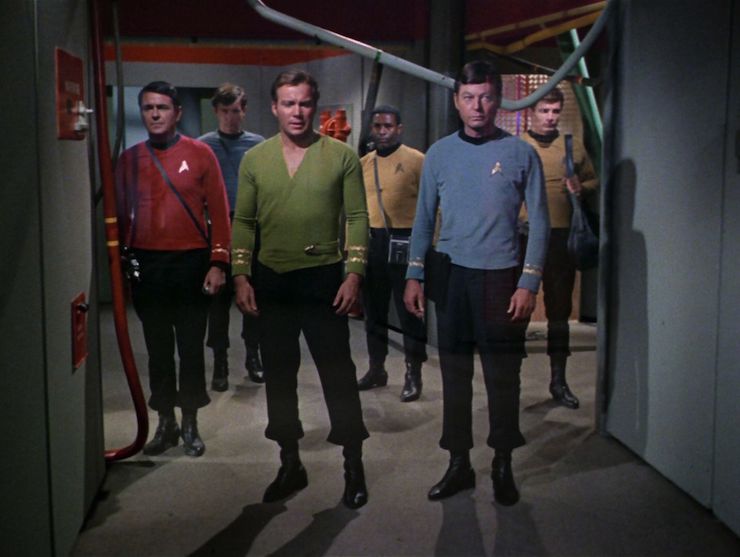
Kirk calls red alert. There are no other vessels in the area, and life-support is still intact on most of the ship, though the bridge is uninhabitable. Kirk downgrades to yellow alert, but maintains battle stations, and he beams over with McCoy, Scotty, and a damage-control party, leaving Spock in charge of the ship.
They find no survivors, but also no bodies. No half-empty cups of coffee or abandoned food. But the only two planets left in the system are inimical to human life. Scotty reports that the warp engines are completely shot, but impulse drive is intact and possibly repairable, and also that phaser banks are completely exhausted—they didn’t give up without a fight.
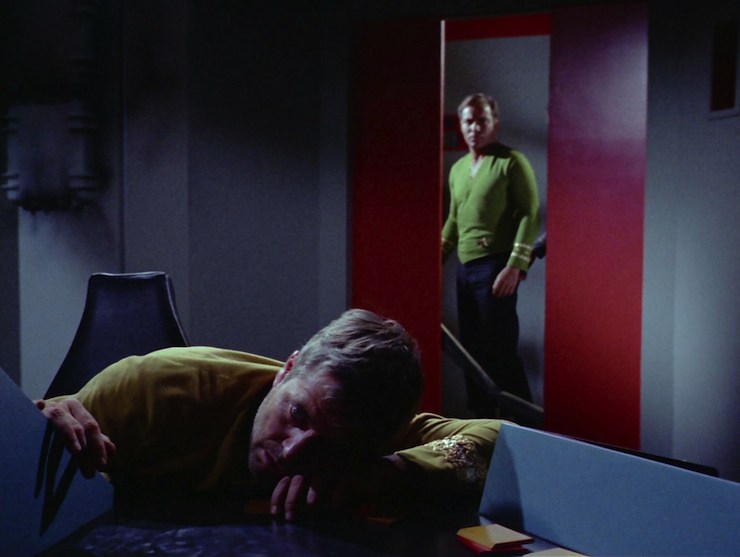
They go to auxiliary control to play the captain’s log, but upon arrival, they find something better: Commodore Matt Decker, the CO of the Constellation. He’s in shock. McCoy is able to revive him, though as soon as Kirk asks what happened, just the idea of mentioning what attacked the ship almost sends him back into a catatonic state.
Scotty plays the log. The Constellation encountered the same destroyed solar systems the Enterprise did, and also the same subspace interference Palmer reported, keeping them from contacting Starfleet Command. They investigated L-374, where the fourth planet was breaking up. The thing that destroyed the solar systems also beat the crap out of the Constellation. Decker says it’s miles long, with a huge maw through which it shoots an anti-proton beam (which actually deactivated the antimatter in the warp drive). They had to abandon ship on the third planet. But the thing hit again before Decker himself could beam down (he was the last one on board, as is proper), wiping out the transporter.
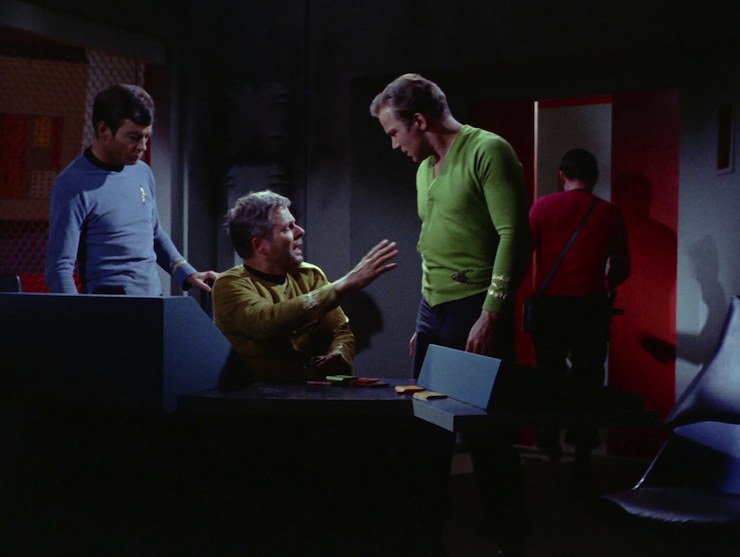
Kirk points out that there is no third planet, and Decker loses it again—he had to sit helpless as the thing destroyed the third planet with his crew on it.
Spock’s view of the Constellation sensor logs leads him to hypothesize that it’s a robot that is self-sustaining by destroying planets for fuel. Sulu has traced the planet-killer’s course, using the devastated solar systems as a base: it came from outside the galaxy, and is currently heading for the Rigel colonies, the most densely populated section of this galaxy.
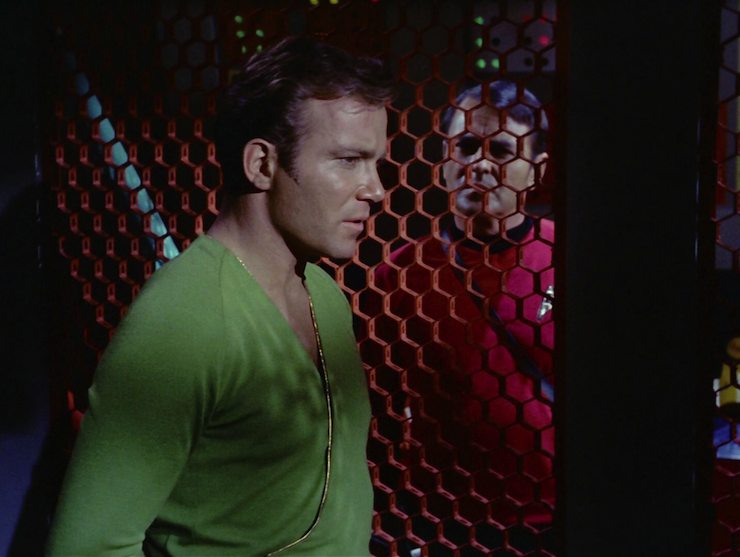
Kirk thinks it might be a “doomsday machine,” an ultimate weapon meant to be used as a bluff—mutually assured destruction, like the hydrogen bomb during the Cold War of the 20th century.
Decker and McCoy beam back so the latter can take care of the former, but as soon as they materialize, Spock signals red alert, so they run to the bridge. The planet-killer has shown up out of nowhere and is pursuing the Enterprise. Before Spock can beam the damage control team back, the planet-killer hits them, wiping out the transporter, and also damaging communications so they can’t pierce the planet-killer’s subspace interference.
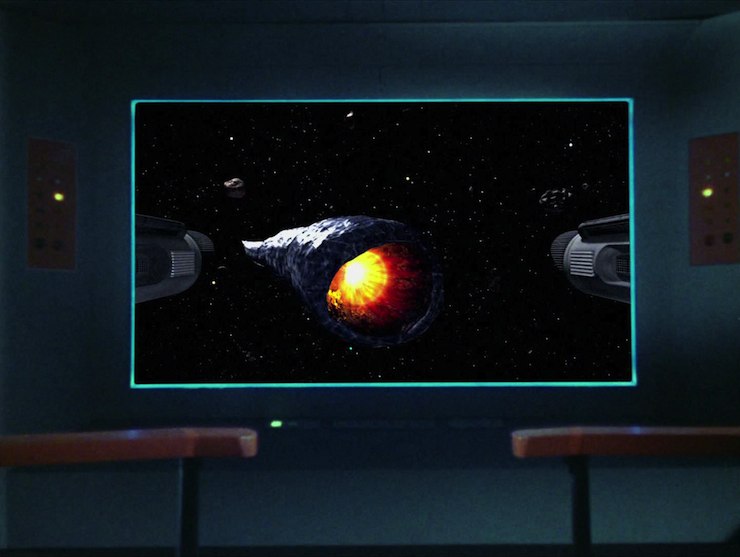
No longer able to contact the Enterprise, the Constellation is blind, deaf, and paralyzed. Kirk orders Scotty to get the impulse engines working while he and Washburn work on the viewscreen.
On the Enterprise, Decker asks Spock for a status report. They’ve managed to outrun the thing, and the planet-killer is now veering off and heading back to Rigel. Spock figures it ignores something as small as a starship outside a certain radius.
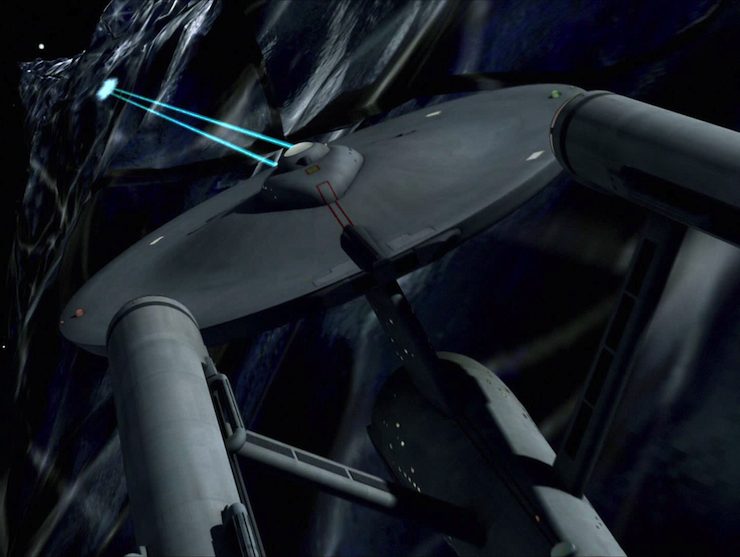
Spock’s plan is to circle back and pick up Kirk and the boarding party, then get out of the planet-killer’s subspace jamming to contact Starfleet and warn the Rigel colonies. Decker dislikes that plan, and orders Sulu to set course for the planet-killer to attack it—this time at point-blank range with full phasers. Decker is a commodore and therefore has the right to assume command under regulations, and he exercises that right. Spock advises him against it—the planet-killer’s hull is neutronium, and one starship can’t fight it. Decker tells him he’s relieved of command, and if he doesn’t shut up, he’ll relieve him of duty as well.
They head for the planet-killer. As soon as they get close enough, they’re hit with the anti-proton beam, which does a number on the deflectors. Decker insists on moving closer.
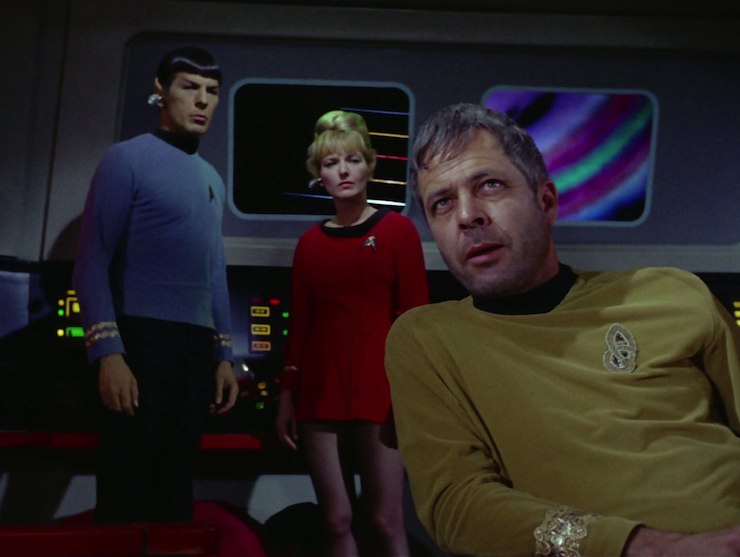
On the Constellation, Scotty has to cross-connect, as the impulse control circuits are fused, so he has to use the warp drive control circuits to manage the impulse drive. Kirk and Washburn get the viewer working just in time to see the Enterprise firing on the planet-killer at point-blank range. Kirk is appalled. Sulu is equally appalled to see that his direct phaser hits all just bounced off with no effect.
The planet-killer hits again, wiping out deflectors, then hits the Enterprise with a tractor beam, pulling it in the way it pulls planetary debris in. Warp drive is now down also. Decker insists on still trying to attack rather than break free, but Spock points out that that is suicide, and grounds for relieving him of duty. Decker reluctantly orders Sulu to veer off—but unfortunately, the Enterprise doesn’t have enough power to pull out of the tractor beam.

Scotty gets impulse engines working, and Kirk pilots the Constellation toward the planet-killer. It is, to say the least, a rough ride, but Kirk soon gets the ship under control. Scotty also has a phaser bank recharged, so Kirk fires a shot at the planet-killer. The good news is that it releases the Enterprise. The bad news is that it’s now turning its attention to the Constellation.
Decker returns the favor, firing phasers on the planet-killer, then pulling away. The planet-killer gives chase, but Spock warns that with only impulse power they are limited in how long they can stay ahead of it, especially since it can refuel easily.
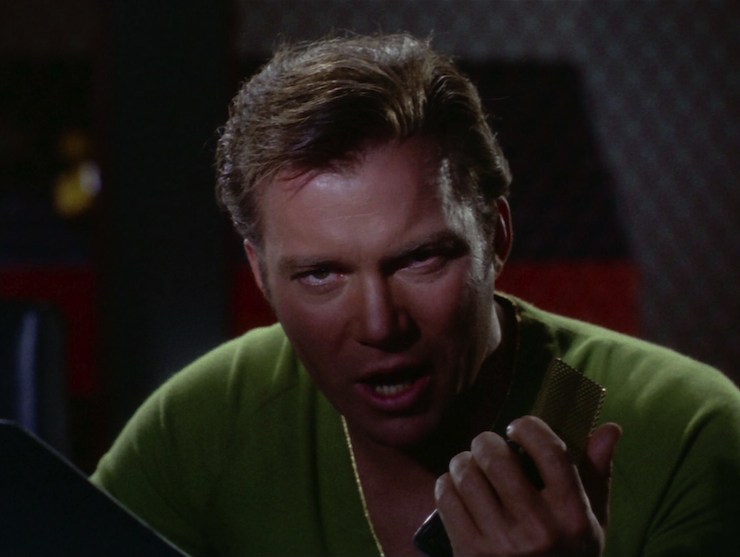
Palmer is able to pierce the interference locally and raise Kirk—who is beyond livid to discover that Decker has nearly destroyed his ship. Kirk orders Spock to relieve Decker on his personal authority as captain of the Enterprise. Decker resists until Spock threatens to put him under arrest—and the two security guards on the bridge are quite ready to do so. Decker reluctantly turns command back to Spock and is escorted to sickbay by one of the guards. Spock then orders Sulu to circle back to pick up Kirk and the boarding party.
Decker jumps his security escort and sneaks to the shuttle bay. He steals a shuttle and pilots it for the planet-killer. Kirk and Spock both try to convince Decker not to throw his life away, but Decker insists on piloting the shuttle right into the planet-killer’s maw.
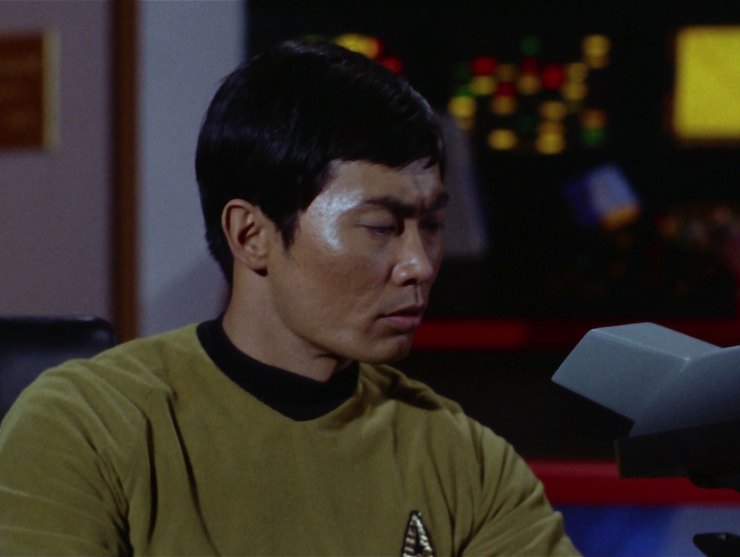
Sulu picks up a minute drop in power when the shuttlecraft exploded. It’s a negligible loss, but it gives Kirk an idea: do the same thing, but with something bigger. Like, say, the Constellation. The transporter’s now working again, so Kirk orders the damage control party beamed back, leaving only Scotty and Kirk on the Constellation. He plans to detonate the impulse engines, using a thirty-second detonation that Scotty has rigged so he can beam back after it’s activated.
However, when Scotty beams back, the transporter goes wonky. Scotty jury-rigs a fix, so Kirk activates the detonation—and then the transporter goes down again. Scotty again jury-rigs a repair and Kirk’s beamed out in the nick of time. Best of all, it works, the planet-killer is now completely inert. Kirk comments on the irony of using something very much like the 20th-century version of a doomsday machine (a hydrogen bomb) to destroy another doomsday machine.
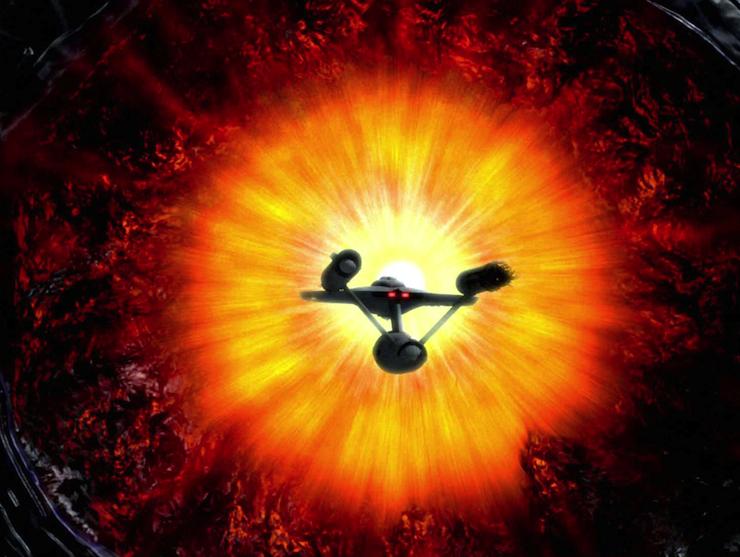
Can’t we just reverse the polarity? Scotty is able to rig the warp drive control circuits to control the impulse drive, get the impulse engines working, and recharge a phaser bank. For an added bonus, he fixed the transporter—twice. Because he’s just that awesome. (He also rigs the thirty-second detonation of the impulse engines, but by his own admission, that’s easy—the hard part is keeping them from blowing.)
Fascinating. Spock remains a stickler for regulations. He advises against Decker relieving him of command, but ultimately steps aside. Afterward, he just stands to the left of the command chair and pointedly stares blankly into space, not even moving to the science station. It’s an interesting form of civil disobedience, as he obeys the letter of regulations, even talking McCoy into not challenging Decker’s competence (because he knows he doesn’t have a leg to stand on), but doesn’t do anything to help Decker, either. He finally takes the science station when it’s absolutely necessary, once they engage the planet-killer. And when he gets a direct order from Kirk, then he relieves Decker…
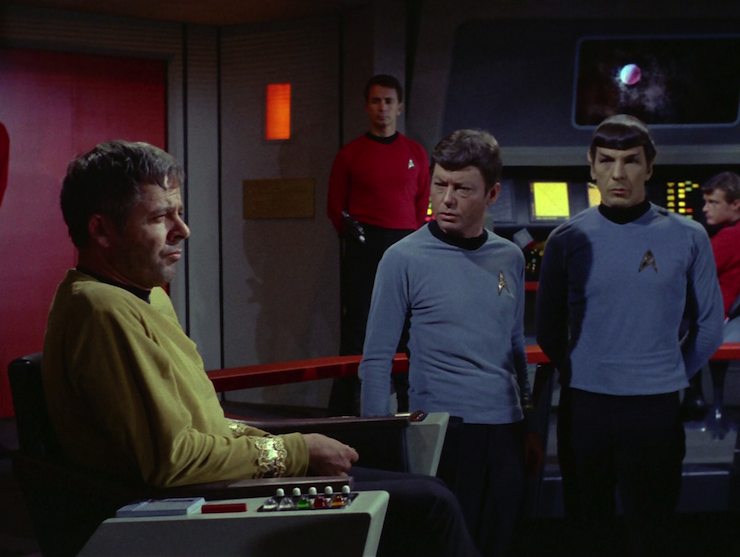
I’m a doctor not an escalator. McCoy’s best line in this episode isn’t actually in this episode. When Decker kicks him off the bridge, the commodore points out that Spock knows his duty under regulations—”do you?” In the episode, McCoy grumpily leaves the bridge without a word, but in his adaptation in Star Trek 3, James Blish gave the doctor the retort: “Yes, sir…To go to Sickbay and wait for the casualties you’re about to send me.” Honestly, for years, I thought that line was part of the episode, it created such an impression on me.
And not just me—the line did wind up being used by an Enterprise chief medical officer to someone in temporary command of the ship: by Beverly Crusher to Captain Jellico in “Chain of Command, Part II.”
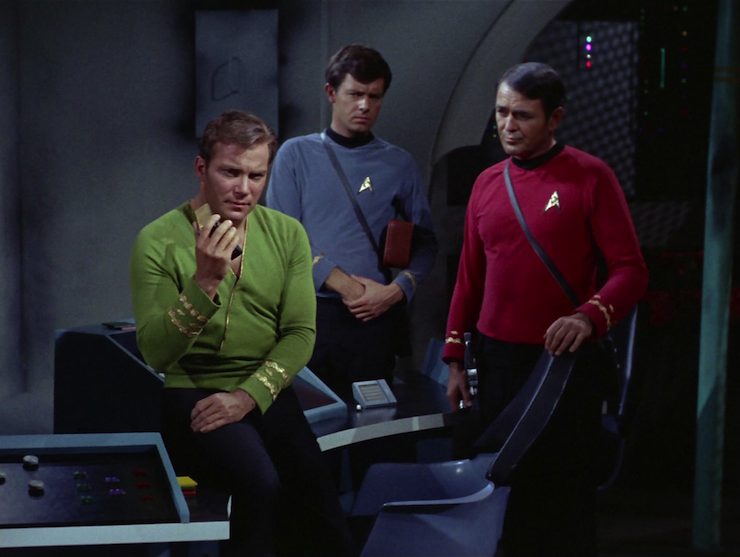
Ahead warp one, aye. Sulu is pretty much responsible for saving the day, as he’s the one who notices the power drop when Decker’s shuttle blew up, which is the key to stopping the planet-killer.
I cannot change the laws of physics! The one and only time James Doohan ever loses his Scottish accent on the show is in this episode, when he’s showing Kirk which switch he’s rigged for the detonation. When he says, “thirty seconds,” it’s in his normal voice.
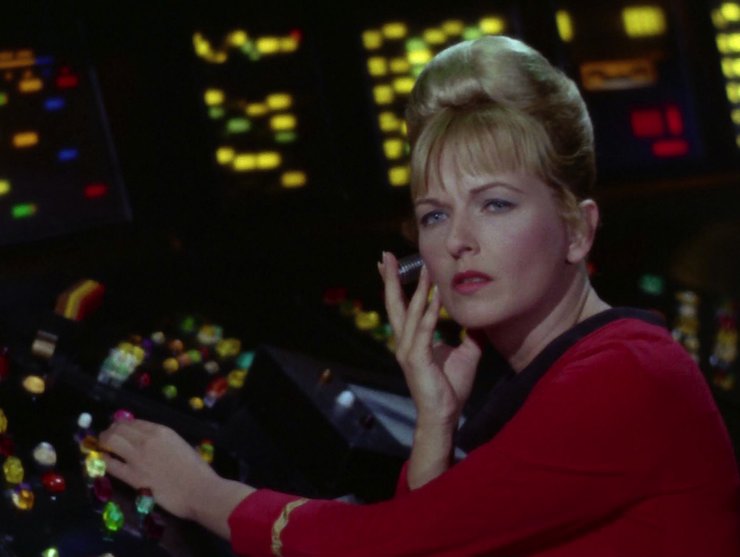
Hailing frequencies open. While we’ve seen lots of different people at helm and navigation, this is only the second time since “The Corbomite Maneuver” that we’ve seen someone other than Uhura at communications, the other being Farrell in “Miri.” This time it’s Palmer.
Go put on a red shirt. Twice, the guard assigned to Decker falls for the tired-old-man shtick. First Decker pretends to have a coughing fit, using that as cover for his first time hitting the guard. Then a few minutes into the fight, Decker pretends to be winded and exhausted, and again uses it as cover to hit the guard.
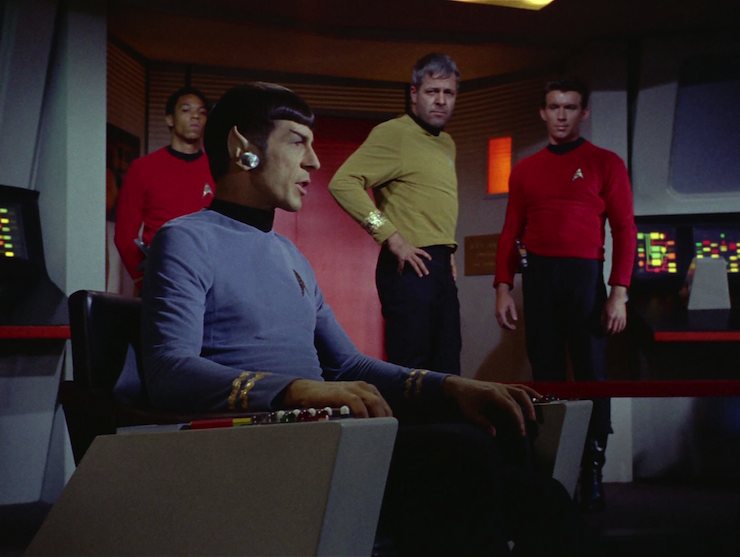
More generally, this trained security guard is incapable of taking down a much older commodore who’s physically and emotionally exhausted from quite possibly the worst trauma of his life, and instead has his ass handed to him.
Channel open. “Random chance seems to have operated in our favor.”
“In plain, non-Vulcan English, we’ve been lucky.”
“I believe I said that, Doctor.”
Spock and McCoy doing the usual banter.
Welcome aboard. The damage control team is played by Richard Compton, John Copage, and Tim Burns. The three characters were named after assistant directors on the show: Charles Washburn, Rusty Meek, and Elliot Schick.
Elizabeth Rogers makes her first of two appearances as Palmer; she’ll return in “The Way to Eden.” Rogers previously did the voice of the Companion in “Metamorphosis.” And we’ve also got recurring regulars George Takei, James Doohan, and John Winston.
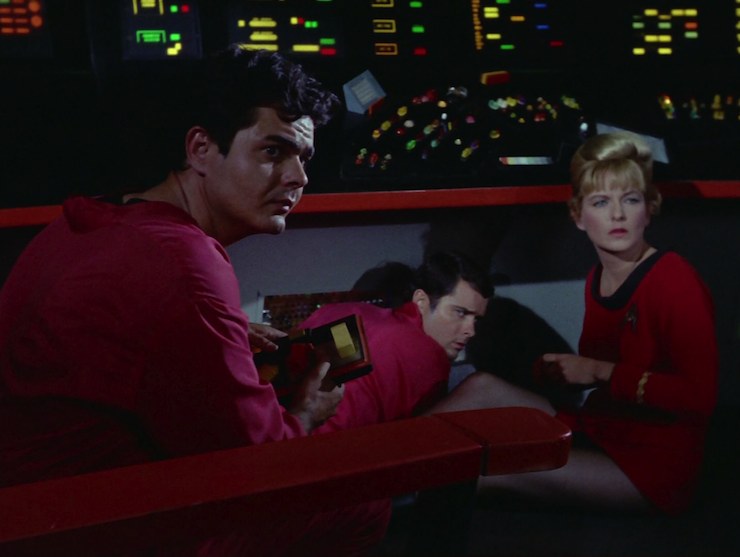
But the big guest is the great William Windom as Decker. He fully inhabits the role, giving him all kinds of wonderful little tics and habits, from the awkward way he sits in the captain’s chair to the way he plays with the data tapes (which Windom has said was inspired by how Humphrey Bogart fiddled with ball bearings when he played Captain Queeg in The Caine Mutiny). He’s a very lived-in character, one of the best guest stars in the show’s history. (Amusingly, writer Norman Spinrad envisioned Robert Ryan in the role when he wrote it, and the producers did try to get Ryan, but he was unavailable.)
Trivial matters: Though it was never explicitly stated onscreen, it was always intended for Willard Decker in The Motion Picture to be Matt Decker’s son. All of Willard’s appearances in tie-in fiction has been written with that in mind.
Your humble rewatcher showed the entire crew of the Constellation in The Brave and the Bold Book 1, establishing the first officer, chief medical officer, and security chief, as well as several other minor characters, and also fleshing out the only other named crew member, Science Officer Masada. That story took place about a year prior to this episode and chronicled the first meeting between Kirk and Decker (since they obviously knew each other in this story). David Mack also portrayed that same crew in Vanguard: Harbinger as well their Mirror Universe counterparts in The Sorrows of Empire.
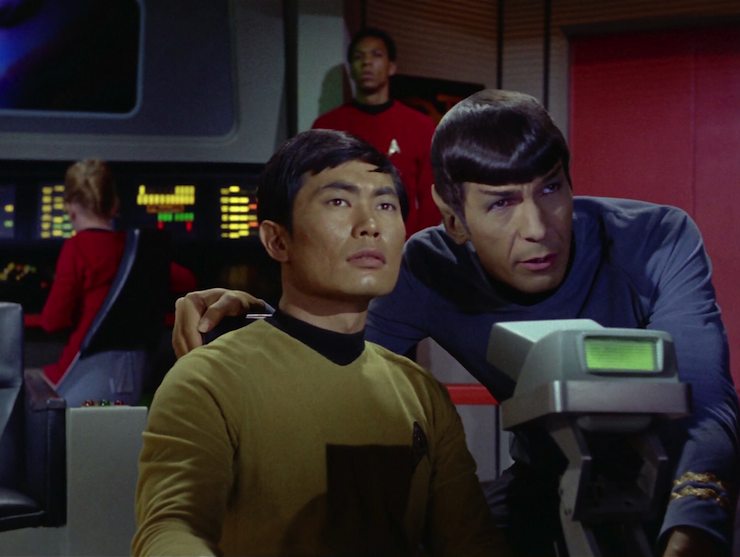
Palmer appears in a few tie-in stories, as well, including the short stories “Under Two Moons” by William Rostler in Star Trek II Stories and “Fracture” by Jeff Bond in Constellations, as well as the Mere Anarchy novella The Centre Cannot Hold by Mike W. Barr.
Peter David‘s novels Vendetta and Before Dishonor established that the planet-killers were originally created to combat the Borg.
Voyager encounters another planet-killer in the comic book miniseries Planet Killer by Dean Wesley Smith, Kristine Kathryn Rusch, Robert Teranishi, & Claude St. Aubin.
This is the first time we see another ship of the Enterprise‘s class.
The new engineering set debuts in this episode, which has more space and a second level. (Technically, it’s the Constellation‘s engine room, not the Enterprise‘s, but the same set will be used on the latter moving forward.) This is also the first time we see auxiliary control.
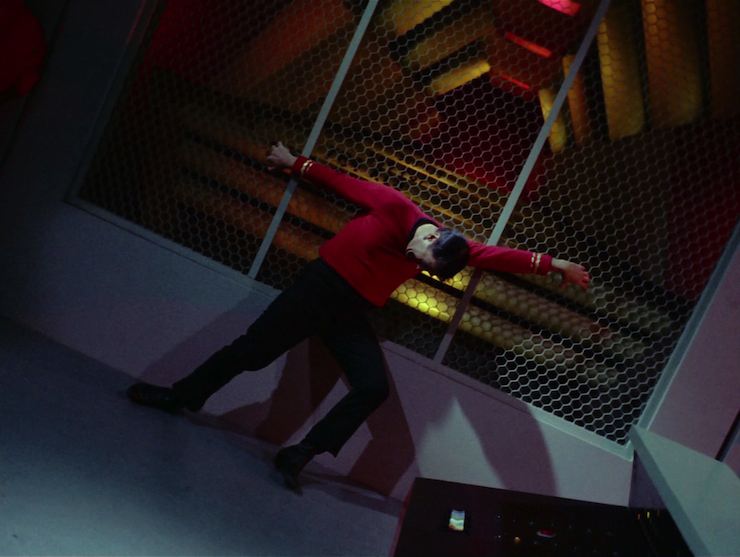
We also see Kirk’s new green alternate tunic, similar to the one from “The Enemy Within,” but with some variations. Kirk will periodically wear it throughout this season.
Norman Spinrad’s story (originally called “The Planet Eater”) took its inspiration from Moby-Dick by Herman Melville. It’s far from the last time that novel would inspire a Trek story—see also “Obsession,” The Wrath of Khan, and First Contact.
Spinrad’s original screenplay had Decker’s first name as “Brand” and didn’t have the commodore’s suicide mission with the shuttlecraft. Instead, Decker lived and decided to retire. Those aspects were seen in James Blish’s adaptation in Star Trek 3.
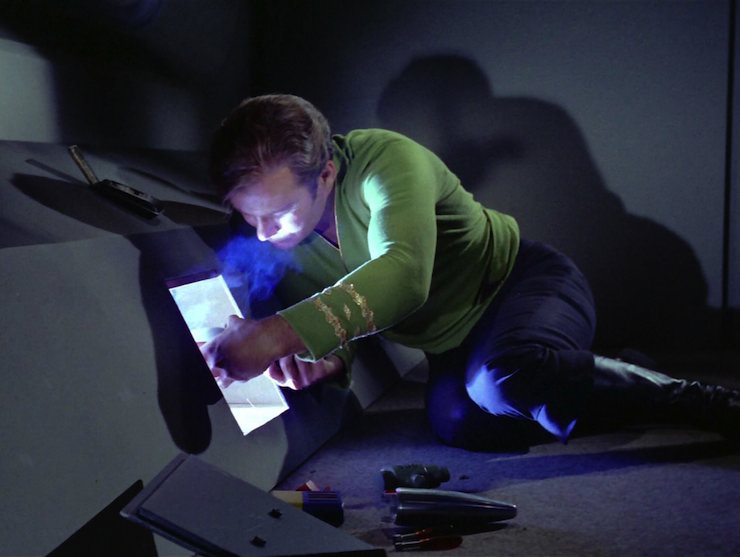
Spinrad wrote two more scripts for Trek that were never produced, “He Walked Among Us,” which he withdrew after he was unhappy with Gene L. Coon’s rewrites, and “To Attain the All,” which was written for the abortive Star Trek Phase II series in the 1970s (that series was scrapped in favor of The Motion Picture). Spinrad rewrote He Walked Among Us as a novel with original characters, and will also be directing the original Trek script for the Phase II fan film series.
When the original series episodes were remastered in 2007, this episode received some of the most changes, with 105 new effects shots (most of the remastered episodes had 20-30 new shots).
This episode was nominated for a Hugo Award for Best Dramatic Presentation in 1968. It lost to “The City on the Edge of Forever.”
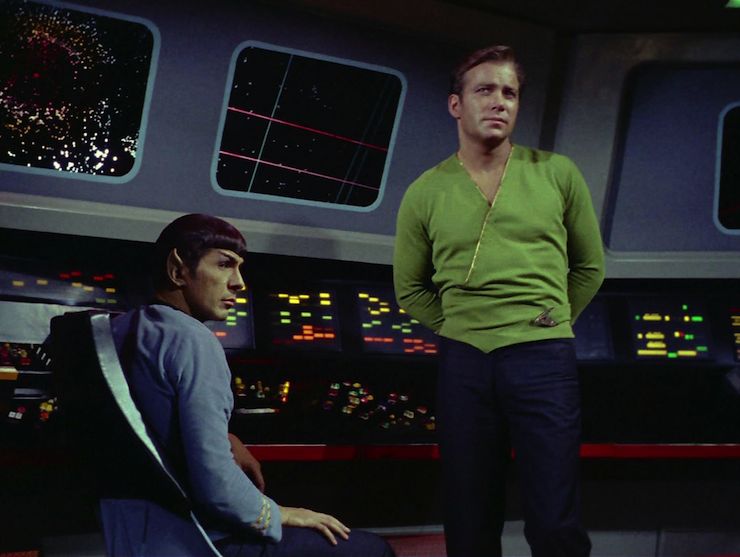
To boldly go. “You worry about your miracles, Scotty, I’ll worry about mine.” I’ve had copies of all the Star Trek episodes on home video since roughly 1987. Initially it was on VHS tapes, recorded off of Channel 11 in New York City, and then I picked up the series on DVD, which I still own. (I have not bothered with the remastered editions, not really seeing the point, as nothing of significance is different about them. That’s why there’s been so little discussion of the remastering in these rewatches.)
I like owning stuff I enjoy on some form of home video because sometimes I just like to plunk an episode in and watch it for shits and giggles. There are a few episodes of Homicide: Life on the Street I like to just plunk into the DVD player, ditto M*A*S*H, The West Wing, Farscape, Doctor Who, and all the Star Treks.
Whenever I wish to watch an episode of TOS, it’s almost always “The Doomsday Machine” that I pick.
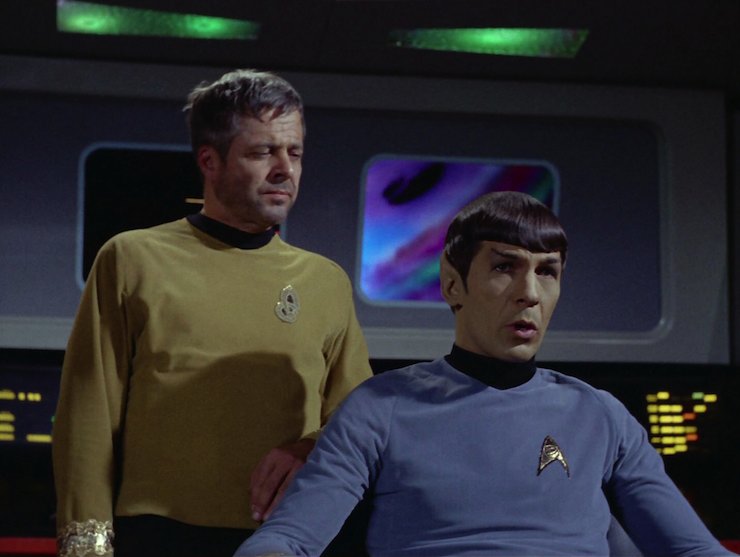
It’s an almost perfect episode. For starters, it’s a strong science fiction story. Norman Spinrad—like Harlan Ellison, Robert Bloch, and Theodore Sturgeon before him—has a strong background as a science fiction writer, and one of the things I particularly love about this episode is that it’s also good science fiction. In particular I like that the script resists the screen SF cliché of Earth always being what’s in danger—the planet-killer’s course takes it to a densely populated section of the galaxy, and it’s not Earth, it’s a set of colonies.
In addition, we have William Windom’s magnificent Decker. Windom brings so much depth to a character who could easily have been a caricature of a crazy person. Unlike, say, Adams in “Dagger of the Mind“—played by quite a fine actor in James Gregory—who was just randomly evil, Decker has very obviously been broken by the loss of his crew. His attempt to make up for it is tragic, but also understandable. And you can just see the stress, the agony, the pain etched on his face throughout.

On top of that, it’s an exciting thrill-ride of an episode, a fun high-adventure problem-solving story that wouldn’t be out of place on a Stargate SG-1 episode. The regulars are all at their strongest here. Scotty’s wry banter with Kirk, McCoy’s crankiness, Sulu’s cool competence, Kirk’s unwillingness to just sit around and do nothing, and most especially Spock’s logic and brains.
Where it loses a point is the climax, which is a bit too drawn out. While the slow entry of Decker’s shuttle into the planet-killer is actually quite tense, the final climax is just endless. It takes forever for Kirk to set up the detonation, then the alleged thirty-second delay between Kirk hitting the button and the Constellation blowing up is actually a minute and seventeen seconds of screen time. Yeah. Plus we have to watch Scotty crawl around a Jefferies Tube twice while Leonard Nimoy is stuck saying, “Mr. Scott” in his usual monotone (because his character isn’t emotional, so the urgency is sucked right out).
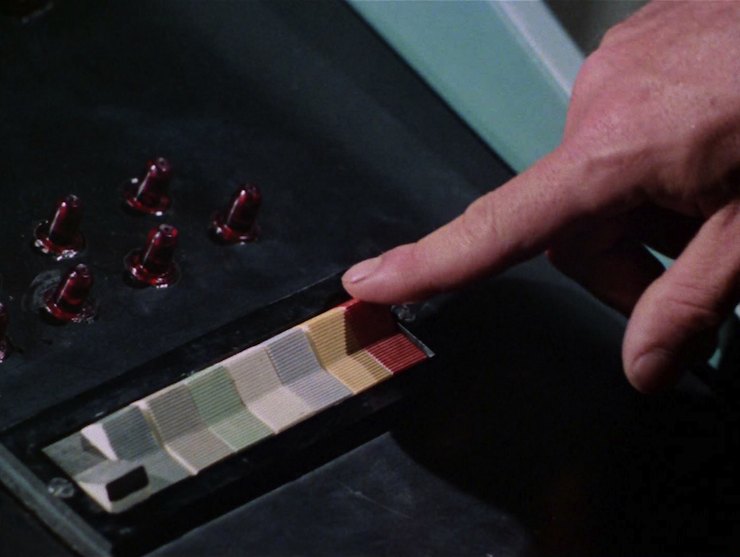
But even with the too-long climax, this is one of the finest hours of Star Trek, just a perfectly put together episode.
Warp factor rating: 9
Next week: “Wolf in the Fold”
Keith R.A. DeCandido will be at Philcon 2015 this weekend in Cherry Hill, New Jersey, along with guests of honor Wen Spencer (author), Richard Hescox (artist), and Murder Ballads (band). His schedule can be found here.










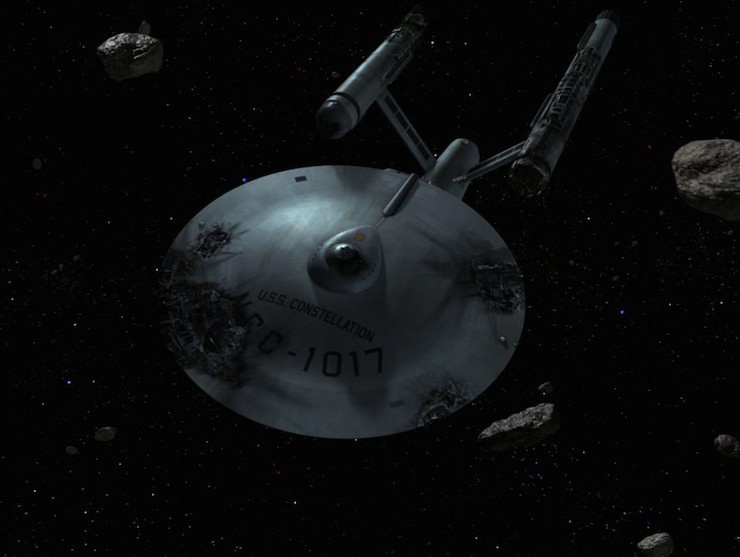

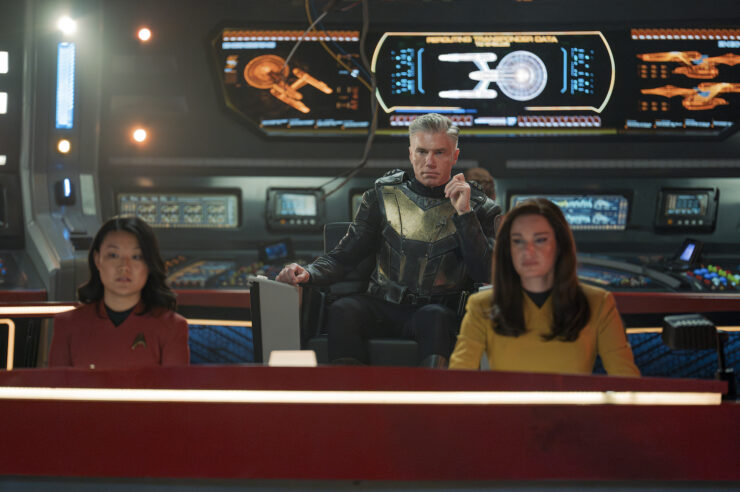
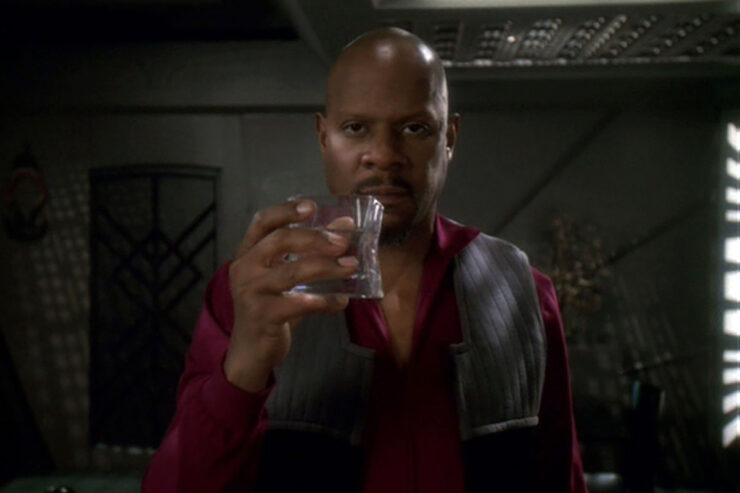
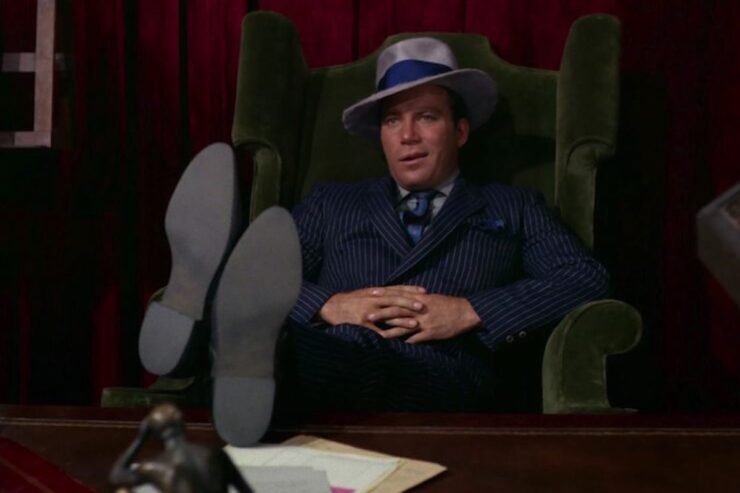
Dang, Krad, it didn’t seem like you were this hard on the other Trek series. A 9 just because the climax was too long?
@1 – Pacing is important, though. I definitely felt the same way while watching.
The unexplained absence of both Uhura and Chekov always made me wonder, though. Did Uhura have a sick day, and Chekov went to the dentist?
“It’s far from the first time that novel would inspire a Trek story—see also “Obsession,” The Wrath of Khan, and First Contact.”
Wouldn’t the fact that all of those came later mean this WAS the first time it inspired Trek, and far from the _last_ time? :-)
2@@@@@; I read once that Nichelle Nichols had a singing engagement the week they filmed TDM. Too bad, it was a great role for the Comm officer.
One point in the script often overlooked: the damage control team report that the Constellation’s filtration system is not functioning. This explains why Decker beamed the crew down…although life support was technically operating “low power level” as Spock says and as Kirk mentions, with the air filtration system down a crew of 400+ would run out of oxygen very quickly. Not an issue with a small damage control team and one survivor. But it does explain Decker’s decision to beam the crew off. He was trying to buy time. Buy time for what, I doubt he knew.
Wait a minute. All of the screenshots are from the remastered version. What’s going on here?
One of the all-time very best, hands-down.
A fantastic script, a brilliant guest star in William Windom, and truly wonderful performances from the regular cast.
I haven’t seen the version with the upgraded special effects, but having just purchased the blu-ray set from DeepDiscount.com, I plan to rectify that very soon. But even with the somewhat primitive FX in the original version, the episode is very strong, and you can’t help but get caught up in it.
Too bad THE MOTION PICTURE couldn’t have done something to establish on screen the connection between Matt Decker and Will. You have to read the novelization and some of the later comics to get the lowdown on that.
I get annoyed by just how craaaaaazy Decker acts on the bridge of the Enterprise, and how everyone goes along with it. There’s this idea in Hollywood that soldiers are just robots and that your brain turns off when the uniform goes on. I’m sure Roddenberry and Doohan knew better from their own days, and they had gotten it right before when Scott wouldn’t drop the shields in that episode with the war fighting computers. The more elite the group, the less likely for them to follow stupid orders from a guy obviously out of his mind.
I feel this episode would have been a million times better if Decker had shaved and changed shirts on the way to the bridge. If he had showed up looking (on the outside) like an officer in command of his faculties, it would have made what comes after much more tense. At that point McCoy would have been the only person on the bridge who knew how crazy Decker was, and so Spock agreeing to let him take command would make more sense. As filmed Spock looks dumb and I keep waiting for McCoy to hit him with a hypo from behind, or for Sulu to “forget” how to fly the ship.
Aside from the craaaaaazy Decker, though, I agree this is top shelf Star Trek.
The whole Decker taking over thing was a load of crap. Spock rolled over on it without invoking any number of regs, including medical ones that Dr McCoy would no doubt have completely supported. Stupid drama device is stupid.
The one and only time James Doohan ever loses his Scottish accent on the show is in this episode,
I love Doohan as Scotty, but his attempt at a Scottish accent is painful. He sounds like he’s trying for Irish and missing.
I suppose it was generally consistent, though.
Keith and I tend to have pretty similar views of a lot of episodes, but not this one. I’m really not that big a fan of “The Doomsday Machine.” It’s basically TOS’s equivalent of a modern special-effects-driven action blockbuster. Its visuals and action were extraordinary for 1967, really spectacular stuff, but there’s not much substance beneath the spectacle. There aren’t really any deeper ideas or philosophical questions or moral dilemmas, it’s just “How do we blow up the big evil thing before it blows us up,” which is really not at all a typical subject matter for Star Trek, more the sort of thing you’d expect from a much shallower show. Sure, there’s the battle of wills between Decker and Spock, but I’ve never found Decker all that effective a character. Unlike Keith, I do think Decker comes off as a caricature. His behavior may be justified by what he’s been through, but he’s still pretty much a one-note antagonist. He doesn’t even really redeem himself at the end; he just lets his monomaniacal, essentially suicidal obsession run its course, and it’s pure luck that it happens to make a difference to the outcome. And I’ve never been that impressed by William Windom as an actor.
Honestly, I think the main thing that makes this episode so effective is its fantastic musical score by Sol Kaplan (his second and unfortunately last Trek score, the other being “The Enemy Within”). It’s a lush, magnificent score that adds emotional power and operatic grandeur to what’s happening onscreen (although occasionally gets a little too melodramatic), and in my opinion, it makes the episode feel like a better story than it really is. I suspect that if “The Doomsday Machine” had been scored with stock music rather than an original score, it wouldn’t be nearly as well-regarded.
Speaking of special effects, what’s fascinating is that if you really look closely at photos of the original Doomsday Machine miniature, it’s evident that it was made by wrapping and Scotch-taping sheets of wrinkled cellophane around what appears to be a wooden or fiberglass (?) cone that was roughly hollowed out inside. (The animation of the lights inside was matted in separately and made with a simple moire effect.) Really an incredibly crude and cheap construction, but amazingly effective onscreen, conveying the impression of being made of some exotic material with a strange inner shine to it. (Which, interestingly, fits well with the claim that it has a shell of neutronium. Neutronium generally can’t exist outside of the crushing gravity of a neutron star, because the degeneracy pressure of its neutrons would overwhelm its bonds and cause it to explode back into normal matter. According to the theoretical work of the late physicist/SF author Robert L. Forward, though, you could theoretically contain a small chunk of neutronium within a shell of synthetic diamond, which would be strong enough to withstand the pressure. So perhaps the planet-killer’s hull was made of neutronium covered in a diamond shell. Although I’d think diamond would be more vulnerable to phaser damage, so it’d be a pretty fragile construct if that were the case. There’s also the fact that DS9’s penultimate episode featured a door supposedly made of neutronium, a material so dense that it would sink to the center of a planet — suggesting that the name “neutronium” is used in the Trek universe for a rather less dense material than the neutron-star matter we use the term for.)
The Constellation, meanwhile, was a modified and damaged version of an AMT Enterprise model kit — which I believe was the first time that the model kit was used on the show, but certainly not the last. I’ve always been bothered by the inconsistency that the model shows no damage to the bridge module, when the dialogue established that the bridge was destroyed.
And I’m torn about the extensive reworking of the episode for the remastering. On the one hand, I like the more highly realistic doomsday machine and starships, but on the other, I really have a soft spot for the giant flying Unicorn horn of the original FX
@11/critter42: I generally like the CGI effects in the Remastered episodes (although I hate the way everyone mistakenly assumes the word “remastering” means “replacing the effects” when actually it means going back to the purest source for the original and making a high-quality copy of it, so that the replaced effects are in fact the only parts that are not remastered), but I find the CGI planet-killer disappointing, because it doesn’t have quite the same eerie translucence as the original. Although in the screencaps here, it looks better than I remembered.
I do think that, with either version, there’s a rather enormous problem of scale. The planet-killer is only a few kilometers long at most. A planet is a thousand times wider than that, so it’s on the order of a billion times greater in volume. It would take ages for this thing to eat all the mass of a planet, even if it annihilated it all into pure energy. And where would it get the equivalent planet-sized quantity of antimatter to annihilate it with? If this thing is supposed to be able to swallow planets and leave only relatively small amounts of asteroidal debris behind, then it should be immensely bigger than shown.
“Vulcans never bluff”. Nice bluffing there, Spock … such a poker face.
So what did they do with the inert planetkiller? Utterly destroyed is one thing but just inert, maybe it simply needs a jumpstart?
One of the top Star Trek episodes. I didn’t find the climax too long at all, I was biting my nails or something the whole time. Nobody in 1967 considered how it would play after the zillionth rewatch and analysis and review.
And I love the score. Coming across (one of) James Lilek’s post about this episode is what informed me there was a soundtrack album released for this episode (and Amok Time).
I give this episode a Warp 11!
There’s quite a few episodes where Trek awkwardly shoehorns moral lessons into the narratives. This episode doesn’t do that—well, maybe a little. I’m just happy they were able to tell a simple, suspenseful story without mucking it up with space gods or some other nonsense.
Windom owns it as Decker. Big and hammy, yeah, but not like this show was known for thespian subtlety. I agree this is a good one for the character of Spock. And I like Shatner’s delivery of: “Gentlemen, I suggest you beam me aboard.” Classic stuff.
I imagine that the Constellation’s detonation reacting with the DM’s power source gutted the internal machinery and all that is left is the outer shell.
Why should a beam of anti-matter (anti-protons) cause the Constellation’s antimatter to go inert?
If memory serves the novelization of ST:TMP had Kirk be a mentor to Will Decker and that he was Kirk’s hand picked successor to the Enterprise (which was part of why he was resentful of Kirk taking direct command of the ship, he saw it as a personal betrayal). The initial similarity of the V’ger crisis to the events of this episode is noted.
I imagine Decker had the regulations on his side (not counting mental incompetence due to PTSD) which is why Spock does not dispute the matter legally, but as a matter of professional courtesy what Decker does is highly irregular.
Decker’s anguished line about knowing that there is no more 3rd planet in the system is the one that gets me on showing that he is a sympathetic antagonist in this story. He is not bad, or venal he is trying to do the right thing but has made a bad decision about what the right thing is.
For the record, the mighty Emmet Asher-Perrin picks the pictures that go with the rewatch. I do find it amusing that she picked so many f/x shots from the remastered version, when I watched the original.
I must confess to bring utterly unmoved by and uninterested in the remastered versions.
—Keith R.A. DeCandido
@15/sps49: There is, in fact, a massive CD box set of all the music from TOS — every single note, even the bits they never actually used in the show.
Speaking of Sorrows of Empire (which is an excellent saga of the Mirror universe), as it progressed through the eras of the second and third seasons of Star Trek, and later the movie eras, I reflected on how other events not present in the book might have been handled in the Mirror universe where the level of cooperation we see in the regular universe is far less or completely absent. In particular I wondered if there was a planet killer in the Mirror universe and how the Enterprise and Constellation crews destroyed it. I can’t see either of them coming up with the solution, especially since it would require sacrificing the Constellation.
On the other hand, if the planet killer was an anti-Borg weapon as Peter David wrote in Vendetta, it is possible that the Mirror universe was different enough that the Borg didn’t exist, or were radically different (and I’m thinking of the Destiny trilogy here, which was also written by David Mack) and the planet killer would never have been constructed in the first place.
@jmeltzer #13: Spock lies and bluffs when it is logical to do so. At other times, he asserts that Vulcans never lie or bluff – because a reputation for scrupulous honesty is a useful thing in any number of ways. Therefore that too, is logical. No?
As far as security guards and Decker – the guy is a disabled starship commander and flag officer. No matter how he acts, you’re going to hold back – your job is to escort him not assault him. Decker was not holding back. He was also a badass, presumably.
CLB@19- Oh, great; now I have to find that! :)
@19/CLB and @23/sps49 – The box set is glorious. It’s expensive, but worth every last quatloo. I tried to comment on Sol Kaplan’s magnificent score for this one earlier today (honest!), but the website went wonky, so Christopher got to beat me to the punch. :) Here’s a link to the box set, by the way:
http://lalalandrecords.com/Site/STTOS.html
Christopher, I appreciate your point that this is mostly an action show, but I am not sure it is as mindless as you believe it to be (@10). The episode’s contemporary political context, which Keith referenced in his write-up, “How do we stop the weapon before the weapon stops us” seems pretty meaty for late 1960s America to me. The doomsday machine is the military-industrial complex Eisenhower had warned the nation about when he left office, gobbling up every resource in its path to keep it fueled and fighting. You can’t reason with it, so Kirk can’t logic it to death. You can only stop it. All analogies have their breaking point; I’m not suggesting the message of the episode is, “Let’s have a violent overthrow of the military-industrial complex.” I’m not suggesting we need no military, no industry. But, like many other systems, it’s a system that can take on a life of its own, as the machine has here (in effect). I think the episode is a warning about that: If we let the “doomsday machines” of our culture have free rein, they’ll do us in – better figure out how to stop them while we can.
#24
Good point, Mike. And it’s interesting the military ship Constellation—okay, exploration ship equipped with military weapons—is used to destroy the mindless doomsday machine. Humans are in control of the Constellation. The machinery doesn’t have full control, hasn’t gotten out of control. Could this be a commentary on military automation in the ’60s? Dr. Strangelove had its own “doomsday device” that was fully automated once humans were out of the picture. A Russian invention, snicker, snicker.
@24/Mike: I just don’t see the political/social commentary. They already did a Cold War allegory in “A Taste of Armageddon,” and that worked because it was about the people making the choices leading to war and the rationalizations they made to perpetuate the conflict, and the choices they’d have to make to overcome it. This is just a fight against a mindless machine. Sure, there’s an allegory there for the danger that our doctrine of mutually assured destruction could run away from us and destroy both sides, but it’s not a major part of the story. Essentially, this is the one TOS episode that devoted itself the most heavily to all-out special-effects action and spectacle. And I respect it as a visual-effects achievement, but I just don’t find it a very substantial story.
And really, there are times when it gets ridiculous, like when smoke pots are blowing up under the transporter pads, and with Kirk’s beam-off being delayed to the last possible second, and just really overblown melodramatic stuff like that. It’s got no subtlety.
@9 As I understand, James Doohan freely admitted that his “Scottish” accent wasn’t particularly accurate. I seem to remember from his autobiography that he based it on the accent of an Aberdonian that he knew in the army during WWII, and noted that if it had been truly authentic, few in American would have been able to understand him.
I can buy that. I’ve been in Scotland, in a couple of places (e.g. Glasgow), I really felt like I needed a universal translator, or at least, subtitles.
One of my favorite episodes and I’d give it a 10 even with a slight pacing problem. Actually I didn’t even notice at first that the ending seems a bit dragged out because at that point they had me half-convinced that Kirk may not make it even with me knowing that no way main character is going to die in 60’s tv series.
I liked seeing Kirk working on repairing the ship, it was a nice detail. Also interesting to notice that he seems to have a fair amount of friends or close acquaintances among other captains despite him still being relatively new and with a noticeable age difference (one would imagine most of the captains are closer to Decker’s age on average).
Wonder what it would really take to relieve a captain of command during crisis situation similar to this one. Obviously McCoy’s medical opinion is not enough without some sort of psych evaluation, and Spock “attempted suicide” line, though it worked on Decker, seems a bit arbitrary especially when some of Kirk’s action can fall into the same classification. It just leaves a lot to interpretation.
While I see Christopher Bennett’s point that the story itself is a rather simple action/adventure storyline without any particular depth or social critique, I think I like it so much precisely because it is such a well done action show. The writing, most of the pacing, the acting, and the characterizations all work together to make a very watchable, compelling episode, IMO.
Commodore Decker is so well realized through the script and Windom’s acting, that, even as we see that he is bat-shit crazy, we also recognize the pain, guilt and helplessness that have brought him to that place. Kirk is the confident, able commander who is concerned for the welfare of his ship and crew above all, but nonetheless risks his own life when the chance to destroy the planet killer arises. We see Spock’s logic and patience when he has to follow regulations when Decker takes command, but his loyalty to Kirk ensures that he removes Decker despite possible consequences further down the line. And, up until the last few moments, the show just clicks right along, with the tension and suspense building every minute.
Really the only thing that detracts from the episode for me is the drawn-out climax. Growing up I remember timing the thirty second countdown and announcing to my family the moment when the Constellation and Kirk should have blown up.
@20: If you’re going off the Novelverse MU, then the Borg do exist (we see them in “Worst of Both Worlds” in the first anthology whose name I’m blanking on at the moment), but they are presented somewhat differently than the main universe version, so that could be the case, yes.
Though you’re assuming they did destroy it. Perhaps in the Novelverse MU, no one was there to stop it and Rigel was consumed? I actually can’t remember offhand if there are any post-23rd-century references to Rigel in any of the Novelverse MU stories/novels.
Darr: when I chronicled Decker and Kirk’s first meeting in The Brave and the Bold Book 1, Decker’s first thought upon seeing Kirk’s face on his viewscreen was, “My God, they’re letting children command starships!” :)
—Keith R.A. DeCandido
I’m splitting the difference here between krad and clb. I liked this one (I’m a sucker for mindless special effects action blockbusters, as long as mindless doesn’t veer off into actual stupid), but I would have liked it better if they had dialed back a bit on the crazy for Decker. He was the captain of a capital ship for the Federation. They don’t give those commands out to just anybody in exchange for collecting box tops. (At least not until the reboot movie.) Plus he’s not just any captain. As a commodore he likely had command of more than just the one ship. He might be grief maddened and not know when to quit, but he should still be good at it when he assumes command. Excellent even.
I generally don’t find Star Trek’s biggest strength to be in doing action for action’s sake. It’s one of the reasons I never appreciated the Abrams films as much as the classic ones or the TV shows. To me, Trek’s at its best when it tackles social themes and explores the human condition in its own pace and storytelling form. It really doesn’t need an elaborate fireworks display of action to pull any of that off. Case in pont: City on the Edge of Forever. Not one shot fired. Another winning example: Voyage Home.
Regardless of that issue, I adore Doomsday Machine. I daresay it’s possibly the pinnacle of the second season (though Tribbles and Private Little War are contenders). It’s one of the best Trek episodes ever done. And it’s not just the action itself, but the characterization and how these people perform in the middle of a complicated situation.
Spinrad’s script addresses some significant details regarding starship design and function and it never once falls into contradiction. It’s great to have a writer who understands the rules of the universe he’s working on, especially when it’s someone else’s creation.
And Decker is probably the best guest character they ever had. Brilliantly performed with subtleties, while also taken to extremes. Everytime I revisit this episode, my opinion of it improves especially because of Windom’s performance. This is a captain whose erratic behavior I could easily understand given the dire situation. In a way, it’s a nice way of challenging humanity’s integrity within the rules of Roddenberry’s box. No one is perfect, and everyone breaks after a certain point. There’s no better character study than this.
I’m really surprised to hear so much praise for Windom. I have never liked him much or thought he was very good. And he was often ridiculously over-the-top in this episode, although he wasn’t the only part that was.
I still remember the parody of this episode (by Kiel Stuart, I think) that appeared in the Best of Trek books, with Decker (or his parody equivalent, for the names were changed) as a raving loon spouting gibberish like “Yokka ibble. Click forp nobble” and “Gwish froop.” (Yes, I still remember those verbatim.) It was that parody that introduced me to the concept of an actor “chewing the scenery,” because he was described as doing so quite literally. So I’m evidently not the only one who found Windom’s performance a bit overdone.
Oh, I thought Windom’s performance was perfectly in line with the tone of this show. After all, the lead actor is none other than William Shatner! It seems like they were swinging for the fences most of the time. Even the usually solid Nimoy had his occasional acting spasms.
In my opinion Star Trek TOS was only a few steps from being the Adam West Batman. Not that that’s a bad thing.
I have to say that I enjoyed William Windom in this episode and, as far as CLB’s comment (#10) that he wasn’t all that impressed by Windom as an actor, I had the opportunity to see Windom in person back in the Eighties doing his one-man stage show based on James Thurber’s short stories; he was excellent. He’d spent a lot of time helping to develop the NBC series (regrettably limited to one season) from his own relationship with the author/cartoonist and he kept the audience on both occasions (there were two versions of the stage show, as I recall) riveted.
There was a lot of bad acting in the day in the original series, but I wouldn’t lump Windom into that category.
Idran is correct — the MU Borg are seen in The Worst of Both Worlds by Greg Cox, which was in Glass Empires, the first of the Mirror Universe trade paperbacks.
—Keith R.A. DeCandido
@34/Christopher – Yeah, that was Kiel Stuart. Her parodies in Best of Trek were some of the best things about those books. I remember laughing heartily at her rendering of Windom’s acting, although I am with the majority here who think he does a really fine job. But I agree, the parody was plenty funny.
@35/George – Have to disagree with you. Only very, very rarely did TOS have its tongue planted in its cheek, as Batman did every week (twice a week)! “Tribbles” has a lot of tongue in cheek, and “Piece of the Action.” There may be moments of it here and there, but I can’t equate the two series, myself.
#38
I didn’t mean the overall series of Batman and Star Trek are equal. I was talking about some of the over-the-top acting, because Trek had a good bit of that. Though I’m not certain the Trek actors were as fully knowing as the Batman actors were. Sometimes it seemed like Shatner was trying really, really hard to be dramatic. “I’M. LOSING. COMMAND!!!”
Anyway, like the tongue-in-cheek episodes you mentioned, they didn’t have to go very far to do campy. Sometimes it worked, other times… oh boy…
@35/39/GeorgeKaplan: If anything, Shatner in the early to mid-’60s was a more naturalistic and understated actor than was typical for his theatrically trained generation. If you ask me, his style didn’t start to get broader until after the on-set explosion that blew up too near him in “Arena” (or maybe “The Apple” — accounts differ) and caused him to develop tinnitus. I suspect that having a loud ringing constantly in his ears made it difficult to modulate his performance.
But really, Shatner’s style is just a stage acting style, which has to be big to reach the back rows. It’s not inferior to the more subdued style preferred today, just different. And I think that there’s an unfortunate tendency to focus on the few excessive instances in his TOS performances, like the one you quoted, and treat them as the norm, which is really not fair. The problem is that we tend to notice the exceptional moments more than the ordinary moments, and so that biases our perception and makes us think of the exceptions as the norm. That’s the basis of caricatures in cartooning, and it’s been shown that people actually recognize caricatures of famous people more easily than they recognize photos of them. Impressionists do the same thing — picking out the most distinctive or exaggerated aspects of a person’s speech and mannerisms and treating them as the norm. Kevin Pollak, for instance, does a terrific Shatner parody, a dead-on mimicry of Kirk’s most extreme moments, but he only does the extremes, and I think that those impersonations by people like Pollak and Rick Overton probably colored people’s perceptions of Shatner’s acting — in the same way that, back in the ’70s and ’80s, a lot of people probably thought of Howard Cosell or Richard Nixon in terms of Rich Little’s famous impressions of them rather than the way they actually spoke. I know it’s easier for me now to remember the sound of Dana Carvey’s version of George Bush than it is to remember the real thing.
As for camp, I suppose there can be a fine line between drama and camp, because camp (at least the Batman kind) is basically taking something silly and playing it as solemnly and dramatically as possible to highlight the absurd contrast. Yes, it’s exaggerated drama, but it’s not that far removed from serious drama, at least the way it was played in the ’60s and ’70s, in less cynical and self-conscious times when being completely earnest didn’t automatically invite ridicule. If anything, it may have been the success of things like Batman and Airplane! and their mocking of hyperseriousness that conditioned audiences to perceive hyperseriousness as automatically campy.
#40
I’m familiar with the story about Shatner’s tinnitus but had not considered it affecting his performance. Interesting. I don’t how those who have it keep from going mad. I know I would.
It is indeed a fine line between camp and big theatrics. I enjoy both. And I’m sure impressionists have probably colored my perceptions of the things you mentioned. But as long as the story doesn’t get totally lost in those theatrics, I still find this series a lot of fun to watch. It’s rarely if ever dull.
While “The Doomsday Machine” is primarily an action episode, there is also some social commentary, delivered more subtly than is usual for TOS. The episode revolves around a weapon that has long outlived its nameless, faceless creators. The script doesn’t really dwell on this point, but I always inferred that the weapon had destroyed its creators before embarking upon its destructive rampage. That long-dead society built an indiscriminate, self-sustaining weapon of mass destruction, and after its creators lost control of it, the weapon became the only evidence that their civilization ever existed. While Kirk does make a passing remark about nuclear weapons, the episode avoids giving us a sermon; instead, it quietly invites us to reflect on the chilling prospect of technology which can destroy its inventors.
On a side note, I was disappointed by the remastered Planet Killer. Especially when one considers the limits of 1960s-era special effects, the original version looked more alien and frightening than the cartoon-like CGI version.
I remember sitting in the living room with my parents when I was probably not even 5 years old (around 1980-ish) watching this episode (one of the local stations ran Trek reruns either right before or after [can’t remember which] The Muppet Show both of which were appointment television on Saturdays in our house), and being TOTALLY captivated, holding my breath wondering if Kirk was going to get off the Connie in time. I’m not certain it was the first time I ever saw Star Trek, but it was certainly the first episode that ever left an impression on me, and because of that it’s always been one of my favorites. Looking back on it as an adult, I find it totally nuts that McCoy had NO grounds to relieve Decker of command when he was clearly PTSD-ing, but the feel-good memory outweighs that for me, and I’ve got to give this one a perfect 10.
I had hoped the remastered version would’ve put the planet killer into a better perspective, but mow I wonder what would a realistic size be?
Decker described it as having a maw (I love that word) big enough to swallow a dozen starships, and that maybe puts it as big as the Spacedock from, iirc, ST:II. But to be big enough to chop up planets, as mentioned above, it should be much bigger! Death Star size, maybe?
The vague-ness of the original helped. The remastered was in too sharp of a focus to feel large to me.
One of the things I like about this one is that it recaptures the sense of having an actual CREW on the ship doing important things, rather than just revolving around the main cast constantly. They had this sense early in the first season but it got lost due to production pressures. In this one that sense is back: Palmer’s quiet competence, security guards at the turbolift corners, the repair crew at the communications console with their “oh crap” look when Decker takes over, Leslie in the background looking concerned, two guys operating the transporter instead of just one, the damage control party, even Decker’s reference to “Science officer Masada” go a long way to creating the feel of real crews and real lives at risk.
I’ve gotta agree with Chris here. I was never impressed by this episode.
@42 @44 I agree with you about the greater menace and creepiness of the original Planet Killer. When I first saw this episode, the fact that the PK was so battered-looking immediately suggested how it had been unstoppably roaming the cosmos for millennia, and its “featurelessness”(that is, no insignia or other identifying marks) was a chilling implication that since whoever saw it was going to die, they didn’t need to know who launched it.
I remember doodling the Planet Killer during boring classes…
I’ve also always thought of it as a different brand of Berserker — an old weapon still going with no mission.
As usual, it does not occur to anyone to just drop the antimatter containment bottle, which would get one a real big bang. (For that matter,instead of firing missiles at enemy ships, it never occurs to them to beam a kilo of antimatter into a structural element of the target).
@48/Liddle-Oldman: I’ve often lamented the failure of ST to explore the weapons possibilities of the transporter (it’s basically a reversible disintegrator ray that can penetrate solid matter, so it would be devastating if you just left out the reassembly stage). But as a rule, transporters can’t penetrate deflector shields, so that generally renders them useless in battle. Although really, once a ship loses its shields, we should be seeing situations where the crew immediately gets beamed into space or the shielding beamed away from the warp core or something.
Also, beaming antimatter is tricky, because you have to keep it within a containment field. If you try beaming — i.e. disintegrating — the containment unit, then the field will shut down and kaboom. It’s understandable why they prefer to deliver antimatter via photon torpedo rather than via transporter.
@46/lordmagnusen: I agree too. It’s done well, but the plot isn’t very interesting.
@45/John Sickels: That’s a good obversation. I didn’t notice that. The next time I watch this episode I will pay attention to it and maybe like the episode a bit better.
My favourite bit is actually the climax, even if it’s too long. I like it that Kirk gets really nervous when things go wrong, and I like how he reacts – not by shouting or getting agitated, but by making two totally gratuitous communicator calls, each one more wordy and polite than the one before.
This is a wonderful episode. My only issue with it is the Constellation. It’s obviously a cheap Enterprise model. The fact that they merely changed a couple numbers around and gave it the number code NCC-1017 is annoying. Supposedly the Constitution class starships were numbered NCC-1700 and up which makes the Constellation’s registry number out-of-whack.
@51/Electone: The numbering scheme hadn’t really been codified at that point. Matt Jefferies had his own personal rationale behind the number, but really “1701” was just chosen because it was easy to distinguish onscreen. And the starship repair chart in “Court Martial” featured a range of registry numbers from 1672 to 1864 (interestingly, the same number used 15 years later for the Reliant in TWOK).
And the model wasn’t “obvious” on the lower-resolution TV sets of the ’60s. Using an AMT model kit was the only way they could afford to show a starship as severely damaged as this, since they couldn’t trash one of their existing Enterprise models. And it’s not their fault that AMT hadn’t yet released a decal sheet with other registry numbers.
Apologies, folks, but due to deadlines and holidays and conventions, there will be no TOS Rewatch this week. We’ll be back on Tuesday the 1st of December with “Wolf in the Fold.”
—Keith R.A. DeCandido
@krad #53 Just be sure you serve real turkey for Thanksgiving! ;) I’m sure you get the reference!! :)
Begging y’all’s indulgence for one more day — the “Wolf in the Fold” rewatch will be up Wednesday rather than Tuesday.
—Keith R.A. DeCandido
Make that two more days…..
—KRAD plowing away at this damn book
Do I hear three more days? Going once….. Going twice…..
Sorry, I couldn’t resist.
Yeah, sorry, folks, I’m going to have to just bag the TOS Rewatch this week. We’ll be back on track with “Wolf in the Fold” on Tuesday. I just now finished the novel, which means I only have time for tomorrow’s Bat-rewatch.
—Keith R.A. DeCandido
I believe this was the first episode I ever watched as a little kid in the original run, and it scared the snot out of me; I don’t think I was able to convince the parents to let me watch the show again for another year.
@10/ChristopherLBennett: “Honestly, I think the main thing that makes this episode so effective is its fantastic musical score by Sol Kaplan (his second and unfortunately last Trek score, the other being “The Enemy Within”). It’s a lush, magnificent score that adds emotional power and operatic grandeur to what’s happening onscreen”
Agreed. The fully-scored nature of these old shows is under-appreciated and goes a long way towards explaining the timeless nature of many of the episodes. It’s really interesting what music can do to reaction shots of people staring at SFX; compare Decker’s climactic scene here with any of the many, many viewscreen-reaction shots in ST:TMP for example.
On Windom – while there is a lot of scenery-chewing going on, one can also point to the editing a bit — just because he acted out-of-his-mind terrified for three minutes before the director called “cut” doesn’t mean you had to use it all.
On pacing – sometimes it’s clear that these shows were on a pretty grueling production line and had to be finalized in a hurry, and in the pre-Netflix/HBO days had to come in at an exact length. So you get the occasional weird stretched sequence, or hurry-up ending. I wonder how much of the original footage is available for some more flexibly-timed “director’s cuts” the next time they milk the cash-cow.
@42/cl142: “On a side note, I was disappointed by the remastered Planet Killer. Especially when one considers the limits of 1960s-era special effects, the original version looked more alien and frightening than the cartoon-like CGI version.”
I agree with this too; when I first got access to the remastered (sic) versions, this was the episode I jumped to. Really a missed opportunity — I seem to recall there was some controversy over how much the new FX would diverge from the original shots, but in this case the low-budget, organic/analog version has it all over the low-budget CGI one.
@59/sardinicus: On the other hand, if the original film elements of the effects shots had survived to be restored for HD, then we’d probably be able to tell much more clearly that the planet-killer was surfaced in wrinkly cellophane and Scotch tape, and it would look terrible. You often see that in restored re-releases of old shows — wires and seams and imperfections that were hard to spot in the original are crystal-clear in HD, and it often spoils the effect.
I still remember reading Vendetta when I was in High School. It basically posited that the Planet Killer in this episode was a functional prototype for a weapon to combat, as Keith pointed out in the rewatch, the Borg. At the time I read the book, I had not seen this episode, though I was familiar enough with the premise to be going on. The two things I remember most about the book are Vastator of Borg (a Ferengi analog to Locutus), and the weapon’s confrontations with Borg Cubes. The first time it faces a Cube in combat, it makes short work of it. The beam tears the Cube to shreds, much like it does the planets it encounters. But it’s the second confrontation that really sticks with me. The Enterprise watches as the weapon prepares to fire at another Cube. But instead of instant destruction, like the first encounter, the beam hits a shield. As they so often do, the Borg had adapted to the weapon, and could now defend against it. It was a chilling way to end a chapter.
Great synopsis of my favorite Trek episode, but I feel you don’t quite give it it’s full measure since you don’t mention one of main reasons that the episode is so stunning and interesting; the music! This is one of the episodes where the music really takes center stage and sets up so much of the story. From the tragic and majestic tones which are present upon discovery of the powerful starship that was torn asunder and “didn’t go down without a battle” to the repetitive thumps (much like the sound of heartbeat) that would similarly build the tension and dangerous anticipation to the movie, “Jaws” as both the enterprise and Constellation do battle against a seemingly invincible foe. For his musical score, Sol Kaplan deserves his due and MUCH credit for making “The Doomsday Machine” the classic Trek episode that it is.
Chiming in on 3 of the topics of discussion. First, someone mentioned pacing, and I think maybe that is what makes me grade this down. Enough already with the 30-second countdown. Watching this now made me think of Galaxy Quest, where the clock always stops at 0:01.
Second, I’m going to have to side with those who think Windom’s performance was excellent. He managed to create a nuanced performance out of a script that had him as a one-dimensional character. That’s not to say captain Decker was in any way subtle in his mannerisms. What I’m saying is, I could see the tortured logic behind his eyes that led him to put the Enterprise crew at risk, and then ultimately sacrifice himself on what he likely believed to be a fool’s errand. His obsession with destroying the Doomsday Machine was not based on any rational belief he could actually do it. He wanted the opportunity to give his life in the line of duty so he could rejoin his crew on death, and he didn’t care how many more people he had to take with him to accomplish that.
Finally, I think there was a deliberate attempt to make a social commentary here. Kirk has not one, but two different discussions with his crew comparing the Doomsday Machine with the 20th century h-bomb. Comes across as a bit ham-fisted at this point, I think.
63. JohnC I agree with your measured insights into the character of Captain Decker. I have always found him an interesting and complex character.
I would say, more generally, with respect to clichéd moments of action or Kirk-spoken social commentary, that this show is now fifty-plus years old and styles change. Also, it was made to be broadcast once or twice and then sent into oblivion, not nit-picked over for the next half century. Consider, also, how much was Kirk’s countdown moment a cliché at the time? I would think not very. Just as Dr. Helen Noel’s jaunt through the air shafts of the planetary psych ward in Dagger of the Mind came eight or nine years before Sarah Jane Smith’s similar mission in Doctor Who, Genesis of the Daleks, and since then a thousand more air shaft adventures. So we have to be a little careful, or relativistic, in our criticism.
I’m surprised by the level of criticism of this episode. I would put it in the top five of TOS, along with City on the Edge of Forever, Amok Time, and the like. I base this not on social commentary or Star Trekishness, but on dramatic (or literary) quality. The complexity of Decker, his need to self-sacrifice, to atone for his perceived sin or failure, the implacability and power of the alien weapon combined with its symbolic applicability, the theme of obsession, which seems indeed the first reference to Moby-Dick, perhaps our basic American text, and the transposing of this great theme from the sea into space, produces a dramatic tale of high aesthetic value.
As for the hamminess, the thespian acting styles, the over-the-top-ness, these are essential qualities of TOS, to be embraced not grumbled at. Only the fans grumble over these things, while American society has long recognized them, along with campiness and earnest social commentary, as among the defining features of Star Trek. The fact that Star Trek was parodied in Galaxy Quest, as mentioned above, is good. Parody is usually a sign of love.
As far as the nuclear theme, it should be noted that the bomb that destroys the earth in Dr Strangelove (1964, only two or three years before this episode was shot) was referred to as “the doomsday machine,” and that the theory of a “cobalt bomb” strong enough to more or less destroy life on earth was apparently toyed with by Cold War scientists in the Fifties, as detailed in Doomsday Men: The Real Dr. Strangelove and the Dream of the Superweapon, by P. D. Smith, and elsewhere, no doubt. This appears to have been part of the common cultural nightmare of the Sixties, and, with thousand of ICBM nukes still in existence, and fools even now recklessly raising tensions with Russia, it should be our contemporary nightmare as well.
@64/Kevin: Adventure fiction has been around since much earlier than 1966. I’m sure countdowns and ventilation-duct crawls were commonplace in the movie serials of the ’30s and ’40s, among other things.
65. ChristopherLBennett: No doubt, but they would have reached a microscopic portion of the public compared to a US network television show. It’s more likely Terry Nation, for example, was channeling Star Trek, at the height of its popularity and influence, than remembering Thirties serials.
@66/Kevin Lindgren: Not at all. In the ’30s and ’40s, movie theaters (along with radio) were the equivalent of what television later became. Everyone went to the movies, and every weekend, the theaters showed whole programs that typically included a newsreel, a couple of cartoon shorts, an adventure-serial chapter, a comedy or informational short film, and two features. And that’s not counting adventure fiction in other media like radio serials, books, magazines, and comic strips.
Besides, Star Trek was not hugely popular in its day. It was actually something of a ratings dud in first run, not really catching on until syndicated reruns. As for Doctor Who, it definitely had people crawling through ventilation shafts and countdowns going nearly to the last second long before Star Trek ever aired in the UK. It’s absurd to think that ST was somehow a pioneer in using those hoary old tropes.
67. ChristopherLBennett
Well, Christopher, I never said it was; in fact I was saying the opposite:
1) That the tropes, however plentiful in the past, were not, in an age of hip satire, addiction to color television, and camp, much on the public’s radar screen when Star Trek, very occasionally used them, and
2) that, in the public mind today, the tropes in question, now unironic and plentiful, might possibly be traceable about five decades back, to Star Trek, and after that run into a wall of obscurity — earlier examples now being all but unwatched.
So Star Trek should not be blamed for using tropes that have become ubiquitous today since they probably seemed fresher back its own day.
It doesn’t really affect my argument how popular old cliches were, or were not, in the Thirties or Forties. There are tons of such old chestnuts, of equal “hoariness,” in Golden Age science fiction, Astounding Stories magazine, Sherlock Holmes stories, perhaps they go back to Varney the Vampire and the penny dreadfuls, or to the Norse myths, but all that would only strengthen, not counter, my argument.
Since I’m not arguing for Star Trek as the source of all hoariness, we’re arguing at cross purposes.
For your argument to work you’d have to propose that the antics of Buster Crabb fighting Ming the Merciless are just as much on the mind of the average American today as the adventures of Captain Kirk, or Luke Skywalker, clearly not the case.
In fact, the reason Star Wars seemed fresh in 1977 is because of the relative obscurity of its pirate movie, cliffhanger, swing-across-the-chasm cliches, which either seemed new to the uninitiated or were taken for sly postmodern references.
As for Star Trek in Britain, again, I was not arguing, in a mere throw-away example re Genesis of the Daleks, (I might just as well have used Babylon 5, or either Galactica) for Star Trek as the source of all Who’s pulpiness, for that would be ridiculous, but
1) that it was heavily and powerfully on the mind of the Who writers, influencing them, Star Trek being increasingly popular all through the Seventies in a land with basically two TV channels, and
2) that any such Trekian cliches, should they happen to work their way in, as they did, are likely to hit the same wall of obscurity I have mentioned and might rebound on Star Trek, perhaps unfairly, the reason I suggested, being “careful, or relativistic, in our criticism.”
(Of course, this doesn’t mean I’m suggesting Star Trek was the only influence on Seventies Who, again, ridiculous. Terrance Dicks’ Robot is clearly inspired by King Kong, several episodes by the great days of Hammer Horror, but these things were on people’s minds.)
More generally, Star Trek’s influence on Who, from the Pertwee era on, is clearly evident, a positive one, as I assume you agree.
Finally, I’m certainly not arguing that Doomsday Machine is full of tired, pulpy cliches. Totally the opposite. As noted by those above, it avoids many cliches, like, for example, an attack on earth scenario.
Personally, I assume that these old “chapter plays” which you mention, a fascination to George Lucas, were beneath the notice of Roddenberry and his gaggle of hip, young, New Wave writers, but I know that they certainly sought to avoid all the great, time-worn cliches of Golden Age fiction, frequently referring disparagingly to the bug-eyed monsters of the pulp era, –but to avoid all cliches, all stereotypes, all easy answers and easy escapes, is, of course, impossible.
So I really don’t see anything in my comment for you to take issue with, beyond a difference of opinion concerning the artistic merit of Doomsday Machine, purely a matter of personal taste.
@68: I’m not following your train of thought at all, but what I was responding to specifically was your question in post 64 about whether Kirk’s last-second countdown was a cliche or not when the episode was new. So you yourself were talking about attitudes back then, so I have no idea why you’re suddenly changing the goalposts to talk about present-day attitudes. And my answer is, of course it was a cliche back then. Whenever fictional characters are faced with any kind of deadline, it’s only natural to take them right up to the last possible moment before they save the day, because that’s how suspense works. Heroes not escaping/defusing the bomb/saving the day/whatever until the last possible moment is no doubt one of the oldest tropes in fiction, and it’s laughable to claim it’s somehow specific to any single work of fiction, Star Trek or anything else. The same goes for something as commonplace as crawling through vents — calling that a “Dagger of the Mind” reference makes as much sense as claiming that someone petting a cat is an “Assignment: Earth” reference.
69. ChristopherLBennett
Yes, well everything is full of cliches, intentional or not, from Doctor Who to Dostoevsky to Shakespeare. Perhaps we can agree that Star Trek’s writers tried to avoid them whenever possible.
Personally I found Spock’s monotone “Mr. Scott’ very tension raising. When Spock goes robotic things are very very bad.
On a ‘reverse the polarity’, Keith missed the obvious one!
Spock tells Scotty – ‘use inverse phasing’ to fix the transporter at the last second!
There are 2 very subtle, easily overlooked little moments that I just love in this episode. The first happens in the opening scene. Kirk is standing, looking at the Constellation, and he decides (and proclaims) ‘she was attacked!’ and at that moment he kind of hops over to his chair and hits the intercom to announce red alert. There’s just something in the way Shatner hit that intercom that totally sells it; doesn’t have to look for it, he just springs into action mode. The next is the way Windom plays the reaction to McCoy’s hypospray, reaching his other arm up to touch the spot, but just instinctively as he’s so deep in shock. Brilliant. The ending was weak, (why not a 5 minute timer eh?) but it will always be in my top 5.
Matt: given how unstable the Constellation engines were, I think the thirty-second timer was reasonable. Remember Scotty said the hard part was keeping the engines from blowing up. So once he armed it to explode, I doubt he would’ve been able to put in that much of a delay, especially given the time constraints they were already under.
—Keith R.A. DeCandido
Keith-
Great analysis of one of my all time fav Star Trek episodes. The special effects re-do was, to me, both well and poorly done. I accept that what they did was recreate the effects just as they were intended to look in 1969. But much better.
On the other hand its a missed opportunity. They could have really upped their game and done so much more. If those guys in the 60s would have had the chance to do some of what we can do today….they would have jumped at the chance! They would have said “Lets do it! Of course”
I also loved the Decker-Security guard fight scene. Not sure how the exhausted, old, smaller Decker knocked out a fit, trained guard, but he did. Funny you said he was “stashed in a closet”! I love it. It makes you wonder what these security guard think when they wake up. “Oh no! Not again!” The other guys in the security lounge must just be like…”You too?”
I also notice his partner, who remained on the bridge for some reason, doesn’t even react when its announced Decker has stolen a shuttle. He has to know then his partner was knocked out or killed or was taken on the shuttle right? Similar situation for “Dagger of the Mind”
Anyway. Good job.
Chris
I’m not any kind of writer – haven’t written much of anything since high school, really.
I’ve had this idea bouncing around in my head for some years now to write a story about the period between Decker’s log entry that was replayed and the time the Enterprise arrives. Just what did the Constellation do, what happened during the attacks on the planet killer, what sort of decisions did Decker make (besides the 20/20 hindsight bad one)? One glitch is that the period of time via stardates between Decker’s log entry (4202.1) and Kirk’s 1st (4202.9) is quite short but Decker has a few days’ growth of stubble, which doesn’t quite make sense.
Anyway, I wouldn’t even know how to begin. Just an idea.
Sorry I missed all this when it was first posted. Anyway, if anyone’s still reading:
What can anyone do to make Decker relinquish command of the Enterprise? He outranks everyone in range. Including Kirk. This is the only irksome point to me about the episode — when Kirk tells Spock to retake command, my thought was, “He can’t countermand a Commodore, can he?”
Other than that, this is a top-flight episode, where the starships act like starships, commanders crack or excel, and even advanced technology can prove mostly fruitless against a relentless enemy with no conscience.
KevinDenelsbeck: That was addressed in the episode. Decker initially refused to acknowledge Kirk or Spock’s authority to relieve him. But Spock had the actual captain of the ship and security on his side. As Spock said, he could order an inquiry at a starbase, assuming they lived that long. Even in the state he was in, Decker recognized that, while he had the rank, he didn’t have the authority, not at that point.
—Keith R.A. DeCandido
Keith,
Thanks for the response. I’m not sure that Decker’s characterization allows him enough rationality to be concerned over consequences when they reach the next starbase or whatever. This guy just lost his whole crew and the only possible palliative is to gain immediate revenge on the thing that destroyed his crew (and, let’s face it, career). But maybe he’s getting minor spells of clarity? :)
Cheers,
Kevin
@@@@@27/Russel H “I’ve been in Scotland, in a couple of places (e.g. Glasgow), I really felt like I needed a universal translator, or at least, subtitles.”
I’m sure these days, if you’re wearing Google Glass, there’s an app for that. And if there’s not, there should be. ;)
(The idea of walking down the street with a pair of glasses that translates and displays subtitles in your HUD greatly amuses me.)
@@@@@41/GeorgeKaplan You learn to tune it out. I have tinnitus (the unfortunate result of listening to my music far too loud in my teens). Most of the time, I don’t even notice it unless I deliberately concentrate on it. It doesn’t seem to have much effect on my hearing overall, though a visit to an audiologist would probably disabuse me of that notion pretty quickly. I’m also overdue for an eye exam. I’m finally at that point where I have to acknowledge that I need reading glasses.
@@@@@ Lots of comments about Windham’s acting: I certainly hope they gave him something to wash all that scenery down with. I don’t know what the sets were normally built from, but it probably makes some pretty dry eating. :)
I’m a member of the group that loved Windham’s work in this one. I’ve never seen him in any of his other performances AFAIK, so I don’t know how good he was overall. But in this episode, he was excellent. If you had locked him in a room with he-whose-name-must-always-be-typed-in-all-caps (aka BRIAN BLESSED), they’d probably break out into spontaneous Ham-to-Ham combat. xD
I think there’s a bit more thematically at work in this episode than a simple action-adventure story. Given the era it was made, the Cold War, it seems to me Starfleet is looking from a distance at the Doomsday Machine, similar to how a tribe of islanders or an Amish community or any neutral people might look at the conflict between the US and the USSR. Had a full-scale nuclear war ignited, those people too would’ve eventually fallen victim with the rest of humanity. Mushroom clouds and radioactive fallout being these all-consuming, inescapable things unleashed across the world, yes, I think that lines up with the gaping maw of the Machine.
Perhaps that’s the greater message. The weapons of war are rarely if ever limited to the battlefield, and their effects are long felt — for everyone.
@81/Hops: I like that. That would tie this episode in with all the first season anti-war episodes I love so much.
I generally prefer the stories where they look back at the Cold War from a distance, like this one or “Assignment: Earth”, to the ones where they reenact it, like “Friday’s Child” or “A Private Little War”.
@79/KevinDenelsbeck I think so. I think Decker realized in that moment, when he sees Spock ready to haul his butt off to the brig to get him out of the chair, that he royally screwed up. I have always believed that Decker would fall into the role of being just as good a captain as Kirk, but he had been broken by the loss of his crew. Considering the reactions Kirk had when one of his crew was lost, can you only imagine how badly he would have taken it if the roles had been reversed and he had to beam everyone down to try to save them, only for everyone to die and there was nothing he could have done about it.? I can imagine Kirk would be no less broken and lost as Decker was.
@79 — The way I see it, it wasn’t a question of Decker worrying about the consequences–but of who the crew, and especially security guards, would listen to. Spock alone might not command enough loyalty to countermand a superior officer, but a direct order from the ship’s actual captain combined with Spock’s iron assurance made it clear who had control of the bridge. The security guards stepping forward on Spock’s instruction made it twice as clear. Decker was just possessed of enough remaining sanity not to make a spectacle of himself trying to take on everybody.
It’s funny that in the main article the security guard’s fighting prowess is discussed. Of all the episodes, this is the one where a guard stands out as actually being a threat. Decker had to work for it–most of the time it’s just a surprise chop or knockdown and the fight’s over, redshirt loses. This one shows him take a fighting stance, and he sells it with his face–he’s committed.
Seriously, it’s still my overall favorite episode of TOS. Some random thoughts follow, and some are very obviously tongue-in-cheek.
A general energy dampening field powerful enough to deactivate antimatter in the warp drive (and presumably in the photon torpedoes since they were never used) can’t seem to dampen things like the nuclear fusion reaction in an impulse engine, the matter/antimatter reaction that powers the ion engine of a Class F shuttlecraft, the rapid nadion effect which generates phaser beams, or any of the lights, environmental, and other systems that still seem to work just fine. “General”? My disbelief died of asphyxiation from being suspended that far…
I had no idea phaser beams were made of bubbles which broke apart when they couldn’t get through their target, which is what the original version phaser impacts on the hull of the DM did.
The sound Montgomery makes when being pummeled by Decker at one point still makes me laugh…sounds like he says “BARRRRFFF!”
30 seconds of on-screen time took 1:17 in real life, a record which stood until 1996’s Independence Day which shattered that with a real-life time of 1:33.
“We’re going to attack something a lot larger than us. It has a weapon that could fry us easily, but it can only fire in the direction it’s pointed.” “What direction will we attack it from?” “Directly in front, right where it can shoot at us.” *ponders the idea for a moment* “Sure, why not?”
One engineer and a three-person damage control team can miraculously repair the battered Constellation enough to move and even shoot a little…yet a nearly fully-staffed engineering department on Enterprise can’t repair most things for at least a solar day. They can barely get the transporter working…but the same engineer beams back aboard and gets the transporter working not once but TWICE in just a few minutes. Either Starfleet needs better engineering officer candidates or Scotty needs to work on his training techniques, ’cause something ain’t right with all that.
Anyone else think Spock’s comment about the shields (“They can’t take much more of this”) seems out of place? Shouldn’t he have been saying that after the first couple of shots from the antiproton beam? Or did he mean that “general energy dampening field” was sucking the life out of them as they got closer? I’m thinking there was an editing goof.
Just how did Kirk see the shuttlecraft? Last I saw, the Enterprise didn’t look that big on the viewscreen, so the shuttlecraft should have been a puny little speck of a couple of pixels at most. *cue more suspension of disbelief*
“Radiation level normal”…seriously? You just exploded a 97.835 megaton fusion bomb and the radiation level is “normal”? Damn, I’d hate to see what you think is “abnormal”…
@85/Patch: I believe the point of “Radiation level normal” was that the explosion was contained within the neutronium shell, so that the radiation level outside (at least away from the maw) is unaffected. The whole idea was that nothing could get through the shell, so the only thing that could destroy it was an internal explosion. So it follows that an explosion inside wouldn’t affect the outside.
This is a top 10 all time Trek episode for me and I always look forward to this episode every time I go through a rewatch. Like Krad, I’m happy with my standard version DVD boxset and I have no intention upgrading any time soon. I must also say that the gold, blue and red hard plastic shell cases are beautiful to display!
William Windom is simply phenomenal as Decker! I totally understand some of the commenters that think his scenery chewing is a bit too much, but I can’t agree. I think he’s a wonderfully entertaining actor and I love every moment of him here. The scene when we first see him is unbelievably tragic and he just oozes the grief of a man who made a terrible, but understandable mistake.
@73/Matt McCann: “…the way Windom plays the reaction to McCoy’s hypospray, reaching his other arm up to touch the spot, but just instinctively as he’s so deep in shock. Brilliant.”
Agreed, that was well done and I think entirely believable.
@12/CLB: My take on the planet killer is that it doesn’t consume the entire planet, it only cuts it up and gets its fill and moves on, leaving the rubble behind. I have no idea if that was the original idea or if someone during the creative process didn’t truely fathom the scales involved. Obviously, a whole planet couldn’t be consumed by something only the size of a small town. I know with the new special effects, the wreck of the Constellation is surrounded by asteroids and that just plays on my theory rather nicely. I don’t think asteroids are seen in the original version though, but I could be misremembering.
Sorry I’m late to this party. Star Trek debuted when I was in high school, so this episode has been one of my favorites for over 50 years! I’d give it a 10. Nevertheless, there are a few things that bug me that haven’t yet been raised.
• Distances are stated in miles, not kilometers.
• The Enterprise and the Constellation are very close to each other: the Enterprise has the Constellation under tow, Kirk can see the Enterprise shuttle, and they’re beaming between the two ships. So what’s all this about plotting courses to get to each other. Kirk even plots an intercept course to the Enterprise as the Enterprise is coming to the Constellation!
• Assuming the planet-killer was first used in a war between two very advanced, space-faring civilizations, the victims never thought of attacking the planet-killer with a fleet (it’s confused by the combined attack of the damaged Enterprise and the barely-functional Constellation) or of firing a few large nukes into the planet-killer’s maw?
Old Dave
•
This is one of my all time favorite episodes across the Trek universe. I love William Windom’s performance. I do think giving Decker the rank of Commodore was unnecessary, and I don’t think they ever gave that rank to another starship commander again. I read the novel Vendetta many years ago and I don’t remember the part about it being built to defend against the Borg but I do recall that it was Guinan’s sister who used one of the planet killers to fight the Borg. And in this episode Sulu had plotted the reverse course of the planet killer that it came from another galaxy. Has it ever been established that the Borg are in any other galaxy but our own? I’m pretty sure it hasn’t. My Favorite scene is when Kirk orders Spock to assume command on his personal authority as Captain of the Enterprise. I also agree with someone else’s comment that the planet killer, and I never thought of this before, should be a lot bigger if it was eating planets. A couple of miles long even a planet as small as Mercury would take a really long time to bust up.
Thanks Old Dave for bringing up the miles to kilometers issue. I believe there’s several episodes where this weird mixup between miles and kilometers is used. As for a particular performance of actors on various episodes of Trek I think it’s just personal preference or opinion on an individual‘s portrayal of certain characters. I know my friends and I have been quoting lines from Star Trek episodes and movies for decades now especially the ones from performances that are over the top.
@89/xyon921: “I read the novel Vendetta many years ago and I don’t remember the part about it being built to defend against the Borg but I do recall that it was Guinan’s sister who used one of the planet killers to fight the Borg. And in this episode Sulu had plotted the reverse course of the planet killer that it came from another galaxy. Has it ever been established that the Borg are in any other galaxy but our own?”
Actually, Peter David retconned that in Vendetta. He recognized a plot hole in the original premise: If the planet-killer needed to devour planets for fuel, how did it maintain power in the intergalactic void, with few or no planets to chow down on? It could’ve coasted at sublight, but that would’ve taken millions of years. So he revealed in the novel that the PK had actually been constructed in a globular cluster just outside the galaxy.
xyon921: they also gave Bob Wesley, the CO of the Lexington in “The Ultimate Computer,” the rank of commodore.
—Keith R.A. DeCandido
I love this episode. William Windom was one my favorite actors and I think he was great in this. At times, maybe a little over the top (like when he first tried explaining what happened and at the end when he’s going into the Machine) but it conveyed how traumatized he was by what happened. He conveys it very well when he’s in command of the Enterprise–the way he sits in the chair, twirls around those recording tapes between his fingers or even how he points to his chair while he tells Spock to “Come here”–it shows how unhinged he is.